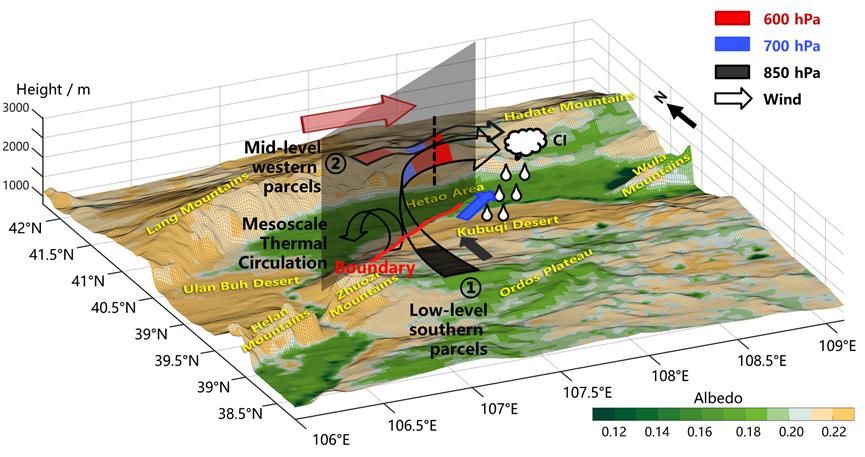植被高度非均匀地区中尺度边界层辐合线及相关对流触发的物理机制研究
孟智勇
对流触发的预报一直是国际上的难题,其关键机制之一为中尺度边界层辐合线。边界层辐合线指具有低层辐合的狭窄区域,通常与地表非均匀导致的热力差异相关,如沙漠-绿洲交界这样的植被非均匀分布区域。然而,目前真实世界中边界层辐合线及相关对流触发的物理机制,特别是植被差异导致的边界层辐合线及相关对流触发的物理机制研究还十分有限。
我们前期的工作(Huang et al. 2019;Huang et al. 2022)揭示了中国黄河河套沙漠绿洲交界地区的边界层辐合线和相关对流的时空分布特征,以及天气尺度特征对边界层辐合线和相关对流的影响。研究表明每年夏季约有60条边界层辐合线沿着沙漠-绿洲分界线形成,其中44%会触发对流,绿洲南侧的库布齐沙漠上空是边界层辐合线相关的对流性降水的高发区域。
基于2012–2016年夏季的天气形势,使用旋转T模态客观分类方法得到的5种天气类型中,河套地区受高压脊所控制的T1型环境最为常见,有利于边界层辐合线的形成和相关的对流触发。作为以上工作的延展,本研究组挑选2013年6月4日这一T1型环境中边界层辐合线在库布齐沙漠上空触发一串对流的典型个例,重点考察真实植被非均匀环境中边界层辐合线及相关对流触发的物理机制。
我们通过WRF模式的高分辨率数值模拟成功捕捉到了与观测十分接近的边界层辐合线和相关对流触发。绿洲和其南侧库布齐沙漠之间地表热力差异造成的中尺度热力环流与低层背景风辐合,在库布齐沙漠上空形成西南-东北走向的边界层辐合线,两侧温差的不断增大和对流层中层短波槽的移近共同导致边界层辐合线的增强。模式所捕捉到的横跨沙漠绿洲交界的热力环流尺度宽约50 km,深度约2.4 km。
我们通过对边界层辐合线触发对流的气块进行后向追踪发现,真实环境中的对流触发有着不同于前人理想环境中对流触发的气块来源。受到真实环境中复杂多变的环境背景风向影响,边界层辐合线对于不同来源的气块具有不同持续时间的抬升作用。边界层辐合线两侧不同的风向造成来自沙漠的气块在边界层辐合线上空转向而近似与边界层辐合线平行,被边界层辐合线抬升了较长的时间,而来自绿洲的气块被边界层辐合线抬升时间较短,只能抬升较低的高度。这种特征造成对流触发的气块都来源于南方沙漠低层和西方绿洲中层,而与理想模拟得到的对流触发的气块主要来自湿区低层不同。
以上关于辐合线触发对流机理的认知主要依赖于高分辨率数值模拟。随着我们研究团队联合八所国内大学和气象研究业务部门在2022年夏季开展“沙漠绿洲辐合线与深对流观测试验” (DECODE) (https://mp.weixin.qq.com/s/GSXz_SB7DeK_u6LXJbq8oA),所获得的大量沙漠-绿洲交界边界层辐合线和对流触发的加密观测数据,有望深化对沙漠绿洲交界辐合线触发对流过程的认知,为黄河河套及其下游地区强对流天气的监测和预报提供重要科学参考。
Convection Initiation Associated with a Boundary Layer Convergence Line over a Real-World Sharp Vegetation-Contrast Area
Forecasting convection initiation (CI) has long posed a challenge over the world, with mesoscale boundary layer convergence lines (boundaries) constituting one of the key mechanisms. These boundaries denote narrow zones characterized by low-level convergence, often stemming from thermal disparities induced by surface heterogeneity, such as transition zone between desert and oasis marked by uneven vegetation distribution. However, research on the physical mechanisms of boundaries and their associated CIs in real-world scenarios, particularly those influenced by vegetation discrepancies, remains considerably limited.
Our previous work (Huang et al. 2019; Huang et al. 2022) revealed the general features of boundaries and their related convections, as well as synoptic impacts on boundaries and related convection along the bend of the Yellow River in Inner Mongolia, China, where a sharp contrast in vegetation exists (mainly between irrigated and desert areas, denoted as HID henceforth). About 60 boundaries form each summer along the desert-oasis border within HID, with 44% of them triggering convection. Particularly. the Kubuqi Desert south of the oasis emerges as a hotspot for convective precipitation related to these boundaries.
By examining daily atmospheric circulations across five summers (2012-2016) within HID, we classified five distinct synoptic patterns using the objective classification method (T-PCA), with T1 emerging as the most prevalent pattern, characterized by a dominant high-pressure ridge over HID. This pattern notably fostered the genesis of boundaries and associated CIs. Selecting a representative case on 4 June 2013, from the T1 pattern, wherein a boundary triggered a series of convections over the Kubuqi Desert, we investigated the physical mechanisms of boundaries and related CIs within a real-world, non-uniform vegetation setting.
Through high-resolution numerical simulations using the Weather and Forecasting (WRF) model, this study effectively reproduced the boundary and associated CIs, close aligning with observations. The mesoscale thermal circulation, propelled by the surface temperature contrast between the oasis and the southern Kubuqi Desert, converged with the lower-level prevailing southerly wind, giving rise to a southwest-northeast-oriented boundary over the Kubuqi Desert. The amplifying temperature contrast between the oasis and desert, coupled with the encroaching middle-level westerly trough, synergistically bolstered the boundary. The simulated thermal circulation between the oasis and the Kubuqi Desert exhibited a width of approximately 50 km and a depth of around 2.4 km.
Based on backward trajectory analyses for air parcels triggered by the boundary, we observed discrepancies in parcel origins for CIs within a real non-uniform vegetation environment compared to previous idealized simulations. Influenced by the intricate background flow in the real world, the boundary lifted parcels from varied sources over different periods. Parcels originating from the low-level southern desert veered, aligning almost parallel to the boundary, resulting in prolonged lifting durations, whereas parcels from the western oasis experienced shorter lifting times and minimal vertical displacement. Consequently, middle-level parcels from the western oasis and low-level parcels from the southern desert attained their level of free convection first, different from the trajectory observed in previous ideal simulation involving low-level parcels originating from the wetter area.
The conclusions outlined above primarily rely on high-resolution numerical simulations. Significant advancements in understanding the formation mechanisms of boundaries and their impact on CI within the HID are anticipated with the implementation of the DEsert-oasis COnvergence line and Deep convection Experiment (DECODE) during the summer of 2022 (https://mp.weixin.qq.com/s/GSXz_SB7DeK_u6LXJbq8oA), which was led by our research group and in collaboration with eight domestic universities and operational meteorology agencies. By leveraging comprehensive observational data collected during this experiment, including measurements of atmospheric parameters, boundary characteristics, and convective processes, we expect to gain deeper insights into the complexities of boundary formation and its implications for CI within HID, ultimately leading to advancements in our ability to forecast CI events and improve early warning systems for severe weather events in this region and downstream areas.
References:
Liu, H., Z. Meng, Y. Zhu, and Y. Huang, 2023: Convection Initiation Associated with a Boundary Layer Convergence Line over a Real-World Sharp Vegetation-Contrast Area. Monthly Weather Review, 151, 1189–1212, https://doi.org/10.1175/MWR-D-22-0083.1.
Huang, Y., Z. Meng, M. Zhang, 2022: Synoptic Impacts on the Occurrence of Mesoscale Boundaries and Their Associated Convection over an Area of Sharp Vegetation Contrast, Geophysical Research Letters, 49, e2022GL099449. https://doi.org/10.1029/2022GL099449
Huang, Y., Z. Meng, W. Li, L.Bai,and X. Meng, 2019: General Features of Radar-Observed Boundary Layer Convergence Lines and Their Associated Convection over a Sharp Vegetation-Contrast Area, Geophysical Research Letters, 46(5), 2865–2873. https://doi.org/10.1029/2018GL081714

图1. T1天气型环境下边界层辐合线触发对流机制示意图。填色为反照率,地形高度用反照率面的高度表示。红色线条代表边界层辐合线的位置,红色箭头、蓝色箭头和黑色箭头分别代表600 hPa、700 hPa和850 hPa的环境风向。气块来源和中尺度热力环流用空心箭头表示,其中的颜色代表对应的高度。垂直于地面的灰色透明面为大致沿着辐合线的垂直截面。每个区域的地名用黄色字体标注。
Figure 1. Schematic diagram illustrating the CI mechanism associated with the boundary in the T1 synoptic pattern. It includes representations of albedo (shading), topography (surface height), the boundary layer convergence line (red line), winds at 600 hPa (red arrow), 700 hPa (blue arrow), 850 hPa (black arrow), and sources of parcels from the CI region and mesoscale thermal circulation (empty arrows). The gray transparent surface denotes the vertical cross section along the boundary. Region names are highlighted in yellow.
